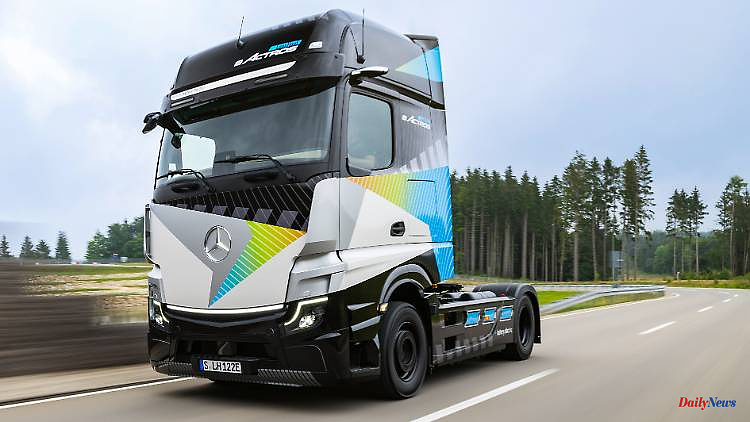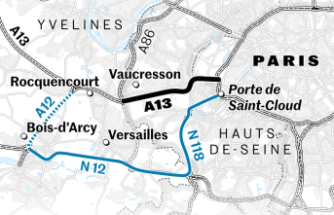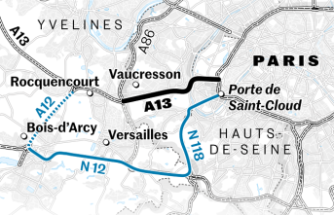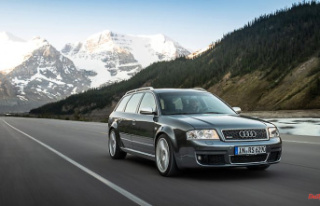The turnaround in mobility is not only an issue for car manufacturers: CO2 limits and high diesel costs are also forcing the commercial vehicle industry to rethink. But unlike with cars, it has not yet been finally decided how the energy should get on board with trucks. But you can already see some things at the IAA Transportation.
The chancellor already knows that. When Olaf Scholz was in Sweden a few weeks ago for a state visit, he not only negotiated energy supplies and discussed the security situation in Scandinavia, but also fulfilled a childhood dream at the VW subsidiary Scania - and took a lap in the truck. However, not in a truck in the true sense. Because the Prime Minister's test car was one of the first Swedish long-distance trucks from Scania with an electric drive, instead of a hum, only a hum could be heard and the Chancellor praised the sporty appearance of a colossus weighing more than 40 tons.
After politicians and other prominent premiere guests, full-time truckers will soon be able to adjust to this: the days of loud and smoking diesel engines in commercial vehicles are coming to an end, the pace is picking up in the slow lane and the elephant race is increasingly being held electrically.
Because the commercial vehicle industry is under pressure: Similar to the car manufacturers, the EU is also putting pressure on the truck manufacturers and, based on the values from 2019 to 2025, requires a CO2 reduction of 15 percent and by 2030 even 30 percent. A lot comes together. According to Eurostat, the cumulative CO2 emissions of all trucks in Europe in 2018 were around 230 million tons.
That is why the strategy consultant Berylls in Munich predicts in a large-scale study "Trucking 2030" that by the end of the decade every third new truck will be CO2-free. And McKinsey expects 85 percent of new registrations to be e-trucks by 2040 and then a share of 60 percent.
How this is supposed to succeed can currently be seen at the IAA. (The IAA Transportation - formerly IAA Commercial Vehicles - will take place on the grounds of Deutsche Messe AG in Hanover until September 25th.) After the commercial vehicle industry has so far mainly electrified vans and trucks for regional distribution traffic, the large ones are now also being electrified Trucks to sum it up: Almost every commercial vehicle manufacturer is also presenting e-trucks for long-distance transport in Hanover and is promising series production for the very near future.
"Although the car manufacturers are still about five years ahead of their truck colleagues," says industry expert Ferdinand Dudenhöffer, "the gap is rapidly closing." He is not only thinking of the Tesla Semi-Truck, which has already been postponed several times, or startups such as Volta and Nikola, nor of the newcomers from China.
While it took the many newcomers to the car world to shake up the established brands, the supposed dinosaurs among the big boys have been there from the start: Whether Renault or Volvo, Scania or MAN - they all have at least the first prototypes presented, with which they want to electrify long-distance traffic.
One vehicle could literally be the number one in the mobility turnaround in the right lane: The eActros, which the world market leader Mercedes is now making fit for long-distance journeys. It won't be sold until 2024, but it will go into public testing this year and will run in fleet tests next year, for example, at the logistics service provider Rhenus and at the shipping giant Amazon.
With the exception of the name, the new model doesn't have much in common with the previous eActros. In order to increase the range to 500 kilometers despite the greater load, project manager Michael Wolf hung more than 600 kWh in the frame instead of batteries with a maximum of 420 kWh and at the same time switched to lithium iron phosphate for the cell chemistry. "This technology allows us more usable capacity and, above all, is more durable," says Wolf, and that is important with such an investment: While cars today are rarely designed for more than 300,000 kilometers, the electric drive of the Actros should be just like a diesel can last at least 1.2 million kilometers and function perfectly for ten years.
There are also more powerful motors for the larger batteries: Because 40 tons have to be moved adequately somehow, the two electric motors integrated in the rear axle have a permanent output of 400 and even 600 kW/816 hp at their peak. For comparison: 400 kW/544 hp are enough in the electric distribution Actros, and the top Actros model from the old world has a six-cylinder with an impressive displacement of 16.1 liters that delivers 460 kW/625 hp - and in normal use it can easily be 30 liters consumed per 100 kilometers.
The technology is slowly gaining momentum and in the medium term the experts even see a cost advantage for electric trucks - although they often cost two or even three times as much as conventional diesel trucks. But until then, there will be an obvious parallel to cars in the mobility turnaround on the right lane: Even with trucks, the change will not succeed solely because of a good conscience - especially since trucks, unlike cars, serve more to productivity than to prestige. "That's why we all have to pull together to reduce the CO2 footprint of the transport industry," says Mercedes manager Dalibor Dudic. The industry has therefore committed itself to installing a European network of 1,700 charging stations by 2025, similar to what it did with Ionity for cars.
And politicians are opening the subsidy box wide: From this fall, the federal government will assume 80 percent of the additional costs when buying an electric truck. There is also an exemption for two tons more weight to compensate for the payload loss due to the heavier batteries and an exemption from the truck toll.
A sticking point for the success of e-trucks, in addition to durability and price, is above all the charging time: "We can't afford long downtimes, a truck has to make money and it can only do that while driving," says Wolf. The developers are therefore focusing on the 45 minutes of rest that long-distance drivers are required by law to take after 4.5 hours of driving. In order to squeeze as much electricity as possible into the batteries during this mandatory break, the Actros works with an operating voltage of 800 volts and already has a maximum charging capacity of 400 kW.
By the time production starts, however, so-called megawatt charging should also be possible, with which the batteries can then go from 20 to 80 percent in less than 30 minutes. The entire truck industry is currently developing a new standard for this and then wants to install a corresponding network along the trunk roads - including automated charging stations, because the cables and plugs with so much power are too stubborn and too heavy to be plugged in by hand .
But unlike passenger cars, the trucking industry is pursuing an alternative technology that will shorten pit stops and improve truck performance. The fuel cell: While the "cold combustion" of hydrogen, which produces electricity and the only exhaust gas is water vapor, is hardly an issue in cars anymore, it is celebrating a happy start in trucks. Firstly, a truck is ready for use again after just a few minutes, the proponents argue, and secondly, regions with a moderately developed electrical infrastructure or a weak power grid can also be supplied with just a few filling stations.
The advantages are understandable and the developments serious: Hyundai has already covered over a million kilometers in the fleet test in Switzerland alone and several manufacturers are driving on two tracks. Not only Daimler is working on a hydrogen giant in addition to the electric Actros for long-distance journeys.
The US start-up Nikola also wants to turn heavy traffic inside out with a dual leadership. Under the leadership of the former Opel boss Michael Lohscheller, the Americans at home in Arizona are just starting the production of a battery-electric truck, which in future will also be built in Ulm with an initial capacity of 2000 units per year in cooperation with Iveco.
From next year, this battery truck will also be flanked by a fuel cell, which has now been presented in Hanover: "With the batteries, we are quickly ready for the market and with the fuel cell we will soon be able to offer electric trucks where the charging infrastructure is not yet sufficient, the distances are too great or the delivery times too short," says Lohscheller - especially since Nikola, like Tesla with its superchargers, also wants to set up its own hydrogen infrastructure parallel to vehicle sales.
How will the race end in the end? Lohscheller believes that fuel cells have an advantage, especially in large-area states such as the USA. But the former Opel boss does not dare to predict which technology will prevail in the long term. On the contrary, he believes that it takes both sources of energy on board the trucks and sticks with the drinkers. "It's hard to stand on one leg."
But electromobility is not the only future topic that the big boys are concerned with. Autonomous driving is at least as exciting. And while the trucks lag behind the cars at the charging station by five years, according to Dudenhöffer's assessment, they are significantly faster than the cars when it comes to autopilot, says the expert: The big monsters are already driving in defined areas and tests are already being carried out on public roads in many regions: " In the next few years, trucks will be the drivers of innovation and will overtake cars."
Incidentally, the chancellor could have gotten an idea of this during his visit to the USA this week if it hadn't just been enough for New York. Because in New Mexico, Mercedes is already on the highway with its autonomous Freightliner - still with a diesel, but without a driver.












